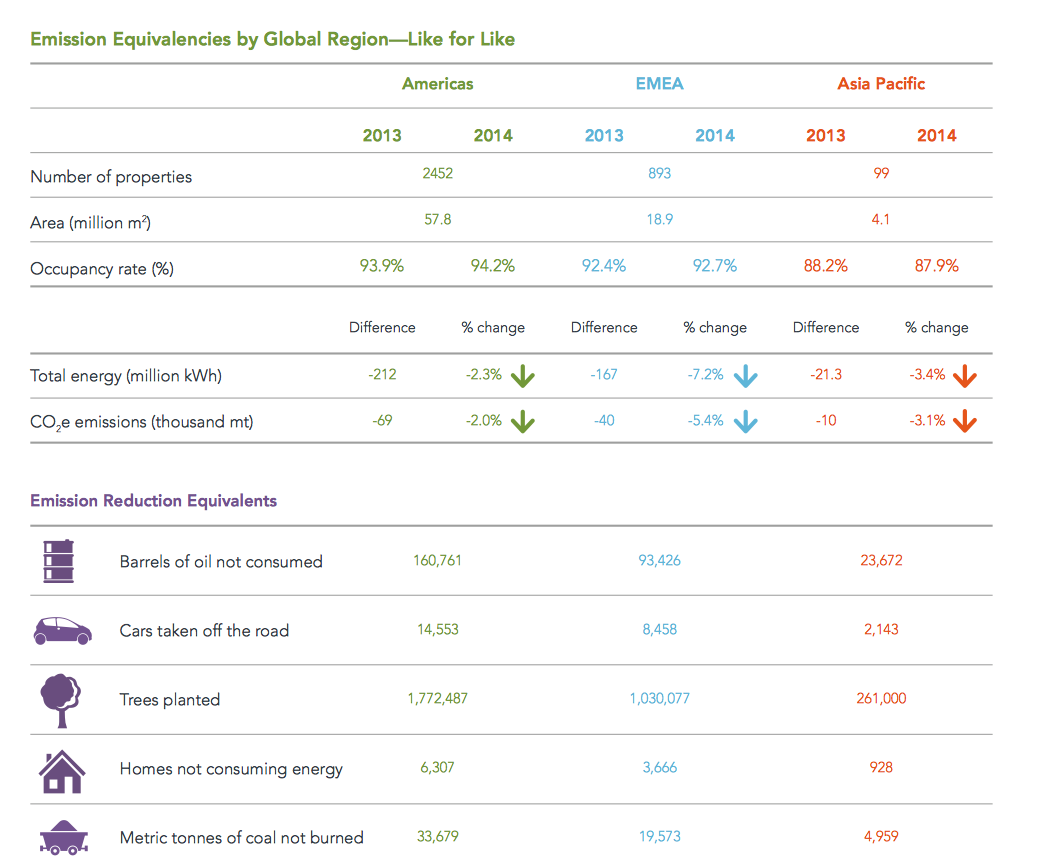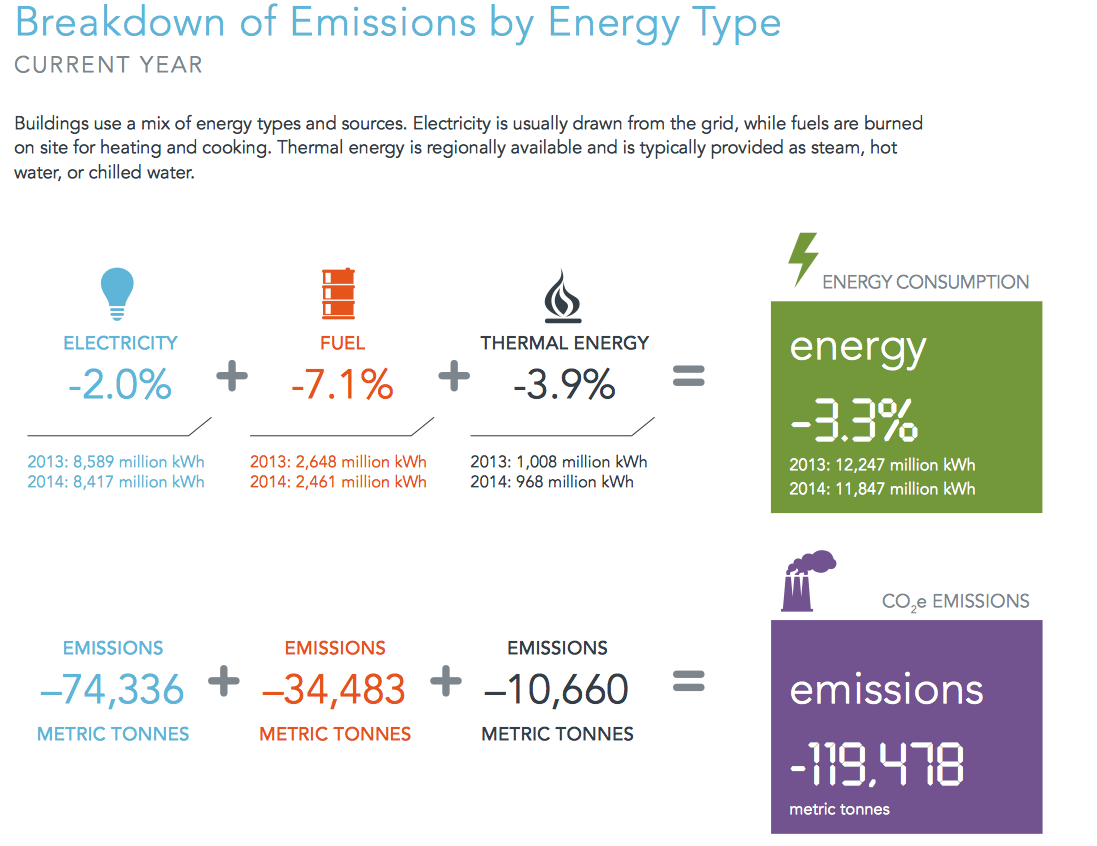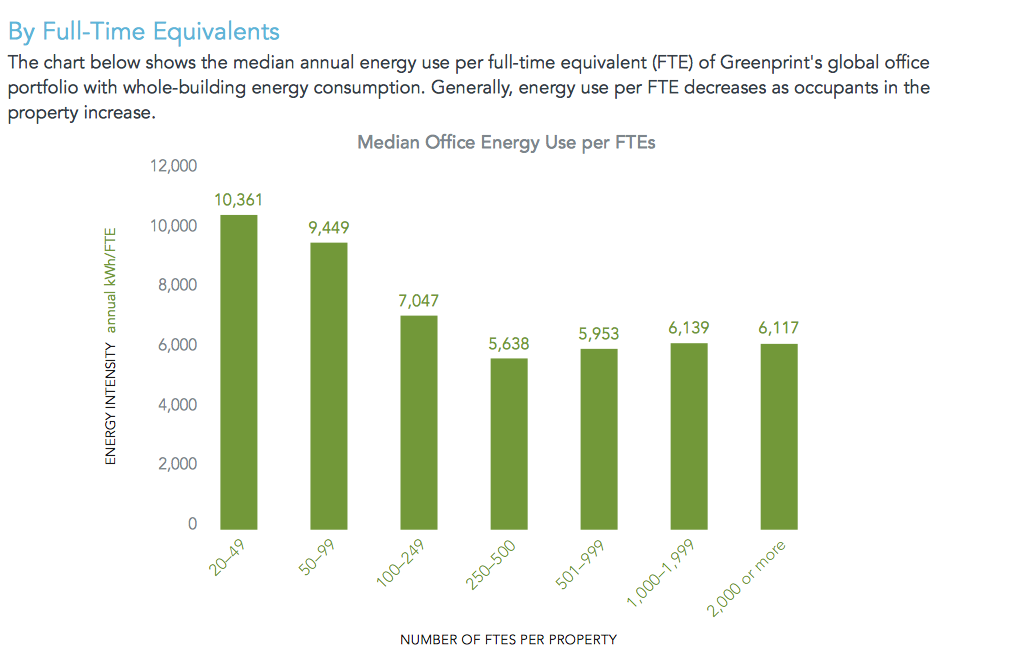Leading real estate companies are achieving incrementally significant reductions in their properties’ energy and water consumption and greenhouse gas emissions, according to the latest Greenprint Performance Report, released by the Urban Land Institute’s Greenprint Center For Building Performance.
This is the sixth annual report from the Greenprint Center, a worldwide alliance of real estate owners, investors, and strategic partners. Greenprint and its members are striving to reduce global greenhouse gas emissions by 50% by 2030. From 2009 through 2014, Greenprint’s membership grew by 140% to 36, and the properties being tracked increased by 768% to 5,224 buildings with 1.2 billion sf in 51 countries.
Over that five-year span, the energy consumption of members’ buildings fell by 11%, carbon emissions by 10.8%, the cost of energy by 4.5%, of electricity by 12.7%, and of water by 9%. Between 2013 and 2014 alone, members reported a 3.3% lowering in energy consumption to 11.8 billion kWh, a 2.7% reduction in greenhouse gas emissions to 4.3 million metric tons; a 2% decrease in electricity to 8.4 billion kWh; and a 1.9% reduction in water use to 54.5 million kiloliters (14.3 million gallons).
Greenprint notes that energy use and emissions reductions in the latest year tracked were equivalent to 277,856 barrels of oil not consumed, 25,153 cars taken off the road, 10,901 homes not consuming energy, 3,063,538 trees planted, or 58,211 metric tons of coal not burned.

While these reductions are laudable, the report doesn’t sugarcoat the magnitude of the challenge lying ahead for a world—and by implication the real estate and AEC industries: Carbon dioxide in the air is at stratospheric levels globally. 2014 was the warmest year since temperatures were first measured in 1880.
As a result, “Sea level, as observed by satellites over the past 20-plus years, has risen by about 75 millimeters (2.95 inches), adversely affecting coastal cities, infrastructure, and the environment globally.”
The report notes, too, that more than half of the world’s population currently lives in urban areas, and that the built environmental produces up to 75% of greenhouse gas emissions in cities. And by 2025, over 1.8 billion people could be living in countries with “absolute water scarcity,” and two-thirds of the world’s population could be living under water-distressed conditions.
The report breaks down its members’ performance data geographically (The Americas, Europe/Middle East/Africa (EMEA), and Asia Pacific), and by industry sector: office (which accounted for 37% of total square footage tracked in 2013-2014), retail (14%), industrial (27%), multifamily (17%), and hotels (5%). The report includes performance data showing the extent that members’ buildings are lowering their waste and improving the biodiversity within their communities.
For each sector, the report offers prescriptive advice by way of case studies, some of which were effective without being all that expensive. The developer/builder AvalonBay replaced 3,575 toilets in 2,546 of its apartments in California, and saved 4.2 million gallons of water per year. In 2015, AvalonBay instituted a California water task force to bring water-efficient projects to scale and support residential engagement and education.

The Starwood W Retreat and Spa Maldives replaced its old air-conditioning system with efficient inverter-type AC units for staff accommodations and variable-refrigerant-flow units for guest villas and the spa. The resort installed heat-recovery fixtures that use generator waste heat to provide continuous hot water. It upgraded room lighting to LEDs and replaced 50 TVs with more efficient LED sets. It installed motion sensors to operate lights and exhaust fans. And it used power analyzer meters for each energy distribution area. Starwood’s total investment of $1,448,392 resulted in a 25% reduction in peak energy load, a 42% reduction in generator running hours (for the years 2011-2014), and $313,051 in diesel oil cost savings for the period 2013-2014.
Greenprint also singles out City National Plaza in Los Angeles, two 52-story office towers and one 40-story pavilion building. Its owner Commonwealth Partners took a holistic approach to upgrading the environmental performance of the property by making improvements to energy, water, indoor air quality and transportation. It now uses sustainable cleaning products for 98% of the building’s area. And it installed high performance filtration equipment and entry mats to mitigate environmental contaminants. The complex reduced its energy consumption by 38%, its water consumption by 40%, and is achieving annual savings of $4.3 million. The buildings’ proximity to mass transit allows an average of 600 passengers to be diverted to public transportation via natural gas fueled shuttles.
On the emissions front, the retrofit, by property manager Grosvenor, of an 811-sf multifamily building in London to Passivhaus EnerPhit standards—which included upgrading to more efficient ventilation, new triple-glazed mock sash windows, and improved insulation and airtightness—is expected to reduce tenants’ energy consumption by 80%, and to cut emissions by 840,000 kilograms—the equivalent of 1,900 barrels of oil not consumed—over the 60-year life of the property.
Bentall Kennedy, which manages two medical office buildings in San Antonio, consolidated quarterly HVAC maintenance under one vendor, retrofitted the building automation system with an interface that allowed better labeling and scheduling, and negotiated a new energy price contract. A $20,460 investment is projected to result in a 25% annual reduction in GHG emissions, and $558,384 in savings over 10 years.



Related Stories
| Jul 30, 2014
German students design rooftop solar panels that double as housing
Students at the Frankfurt University of Applied Sciences designed a solar panel that can double as living space for the Solar Decathlon Europe.
| Jul 28, 2014
Post Tower Wins CTBUH 10-Year Award
The 10 Year Award recognizes proven value and performance in a tall building, across one or more of a wide range of criteria, over a period of 10 years since its completion.
| Jul 24, 2014
MIT researchers explore how to make wood composite-like blocks of bamboo
The concept behind the research is to slice the stalk of bamboo grass into smaller pieces to bond together and form sturdy blocks, much like conventional wood composites.
| Jul 17, 2014
A harmful trade-off many U.S. green buildings make
The Urban Green Council addresses a concern that many "green" buildings in the U.S. have: poor insulation.
| Jul 17, 2014
A high-rise with outdoor, vertical community space? It's possible! [slideshow]
Danish design firm C.F. Møller has developed a novel way to increase community space without compromising privacy or indoor space.
| Jul 16, 2014
Check out this tree-like skyscraper concept for vertical farming
Aprilli Design Studio has stepped forward with a new idea for a vertical farm, which is intended to resemble a giant tree. It uses lightweight decks as outdoor growing space, adding up to about 25 acres of space.
| Jul 15, 2014
A look into the history of modular construction
Modular construction is more than a century old, and throughout its lifespan, the methods have been readapted to meet specific needs of different eras.
| Jul 14, 2014
Meet the bamboo-tent hotel that can grow
Beijing-based design cooperative Penda designed a bamboo hotel that can easily expand vertically or horizontally.
| Jul 11, 2014
Are these LEGO-like blocks the future of construction?
Kite Bricks proposes a more efficient way of building with its newly developed Smart Bricks system.
| Jul 10, 2014
BioSkin 'vertical sprinkler' named top technical innovation in high-rise design
BioSkin, a system of water-filled ceramic pipes that cools the exterior surface of buildings and their surrounding micro-climates, has won the 2014 Tall Building Innovation Award from the Council on Tall Buildings and Urban Habitat.

















